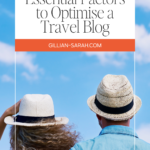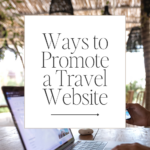
Essential Factors for a Well-Optimised Travel Blog
Table of Contents
ToggleSharing is caring!
Reading Time: 5 minutes


Travel and tourism are very popular blog niches; if these are your passion, it's time to make a living out of them through blogging!
That said, writing about beautiful destinations is one thing; optimising blog posts for a stronger online presence is another. SEO or search engine optimisation has yet to have a single approach that works for all industries. It's not something you can set and forget. You'll need to implement the best travel SEO strategies to dominate the searches. How to optimise your travel website? Here are some tips:

What Makes Travel SEO Different?
The travel and tourism industry is a trillion-dollar market, and the booming industry is quite popular in online searches. Comparison sites, online travel agencies, travel transport businesses, and even travel inspiration platforms attract millions of visitors daily.
Travel is a saturated market. You won't attract readers and gain an online following if you cannot stand out from the thousands of other travel sites.
Your travel website must be well-optimised and filled with engaging posts with attractive visuals to stand out. Your content must be relevant to your ideal client's needs and intent to boost brand exposure and generate organic traffic.
Essential Factors to Optimise a Travel Blog
Matching a user's intent requires customised SEO and a carefully crafted marketing plan. Aside from optimising every post with your primary keywords, which takes researching, getting Google, Bing, and other major search engines to index your blog site should be your top priority. Here are some tips that will help your travel site to stand out and top the searches:
Use Bullet Points
Have you noticed how searches on Google lead to bulleted lists? This shows that Google prioritises websites that use bullet points. Formatting is crucial to the success of your travel blog site.
Bullet points are popular in travel-related blogs because they are easier to read. The infos are presented clearly and in small, easy-to-digest chunks, allowing easy navigation. Most people cannot spend much time reading a long-form article on a mobile device.
You can have the most well-written blog post coupled with stunning images, but if the formatting is off, the post won't attract readers. Ensure that essential infos or takeaways are written in a bullet list on every blog. Long texts should be broken into paragraphs in precise order.
Mind the Word Count
The length of every blog post also affects its search rankings. Travel posts are longer than average blog posts at an average of 2500 words to achieve a higher search ranking. Some of the highest-rated travel sites have 57% more words than the average blog post length because users would often choose travel posts with the most information.
That said, avoid fluff. The writing must be clear, relevant, and comprehensive. What's important is to answer a user's question with relevant, informative content. If Google deems your blog post relevant, it'll naturally rank higher in the searches.
Use Captivating Images
What's a travel blog without stunning images to captivate your audience? Besides providing information, travel blogs are meant to inspire people to go out there and find the best places to visit on their next holiday break or, at the very least, have an idea of what to expect when visiting a specific tourist destination.
When creating a blog post for your travel site, it's not enough to add beautiful images. Again, relevance plays a central role in search rankings. The photos should be in line with the blog post's content. Random images that do not support your storytelling are a no-no.
The size of the image is just as important – especially if you are doing cross-promotions on social media sites like Instagram and Pinterest. Check the best image dimensions for these social media platforms and what perspective (horizontal or vertical) gets the most traffic. It's equally important to compress the images so your website loads faster.
Add Internal Links
A defined internal link structure allows SEO juice to flow naturally on your website. This helps users navigate your content seamlessly. This goes especially for larger websites with thousands of website pages.
When readers don't have to go to Google to search for a destination after reading your post, you make them stay longer on your website. For example, suppose you were talking about spending three days in Japan in a post and added a couple of links that lead to other helpful posts you've written previously, all related to Japan (what to pack in Tokyo, best shopping spots in Osaka, popular souvenirs to get in Shibuya). In that case, they don't have to search elsewhere for these infos.
Meeting the needs of your readers makes a website more credible in the eyes of Google. Google prioritises websites with higher internal links. Search bots can crawl and index content efficiently with a defined link structure. By adding more internal links in every blog post, you are getting a competitive edge against popular travel blogs.
Ways to Promote a Travel Website
What marketing strategies should you implement to achieve a solid online presence while positioning yourself as an expert in your chosen niche? Here are some tips:
Content marketing: Attract readers and promote your travel site by creating well-written, high-quality blog posts. Add visuals like stunning images, videos, and infographics to make every post engaging.
Social media marketing: Use popular social media sites like Instagram, Facebook, TikTok, and Twitter to drive organic traffic to your travel website. Choose social media sites that your readers frequently use for optimum exposure.
Email marketing: Building an email list should be a priority before creating a website. Growing your list and creating an online community will open the doors for more moneymaking opportunities in the future! Create a weekly or bi-monthly newsletter, get people to sign up for it, and start collecting user infos for future marketing.
SEO: Optimise every blog post and piece of content using your primary keywords. Always mind the keyword density so you don't get penalised by Google for keyword spamming. Compress images for faster loading times.
Pay-per-click (PPC) marketing: Once you get higher traffic, you can begin exploring PPC marketing. Platforms like Google AdWords, Facebook Ads, and Instagram Ads let you create attractive adverts to attract more followers and drive traffic to your website or social media posts.
Affiliate marketing: Signing up for affiliate marketing programs lets you monetise your website and increase traffic. Amazon, ClickBank, eBay Partner Network, and Rakuten Affiliate are some of the biggest affiliate programs to check out. Be sure to market products that are relevant to your niche.
Influencer marketing: Influencer marketing may sound like a new concept, but if you've been blogging for a while, it's similar to looking for guest post opportunities or collabs with other bloggers. Look for travel sites and bloggers willing to work with budding influencers like you. You can leverage other brands'/bloggers' audiences through influencer marketing to generate traffic and revenues. This will involve a lot of cross-promotions to gain a huge following.
Topics for Boost Your Travel Blog Traffic
If you're new to travel blogging or you're running out of ideas, here are evergreen blog ideas to add to your content strategy:
- Top 10 Destinations to Add to Your Travel Bucket List
- Planning a Perfect Getaway on a Budget
- The Ultimate Guide to Solo Traveling to [Insert Destination]
- 10 Must-Try Dishes from Around the Globe
- Top 10 Hidden Gems in [Insert Destination]
- What to Pack When Flying to [Insert Destination]
When it comes to building a solid online presence, you have to do more than simply optimising a travel site with keywords. Focus on delivering value above all else. Add captivating images, videos, checklists, and useful infos to every post.
Many travellers have a limited budget, so providing money-saving tips are always popular in searches. Solo travel guides, backpackers guides, etc., provide valuable infos about finding safe accommodations and choosing destinations with reasonable rates. Offering recos for specific locations, sharing unique experiences, and highlighting off-the-beaten-path places are popular in travel niches.
Most Popular Posts:
Sharing is caring!
PLEASE COMMENT BELOW